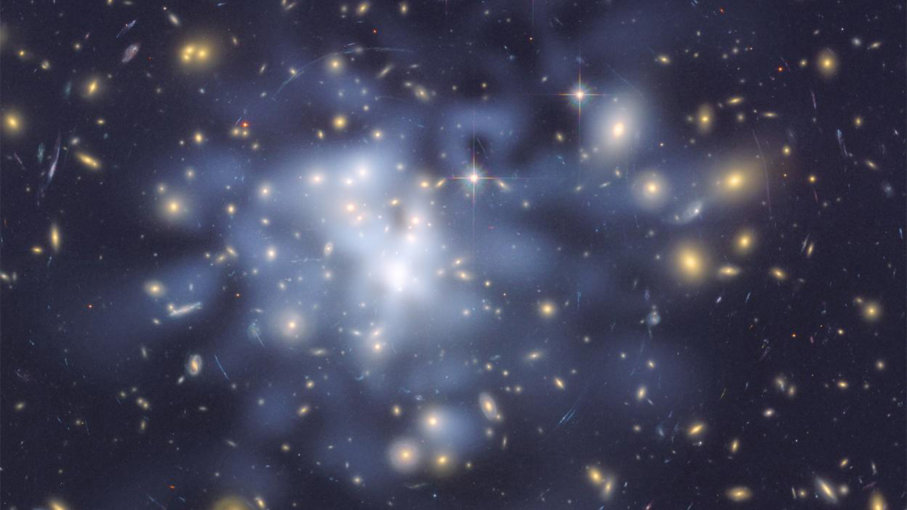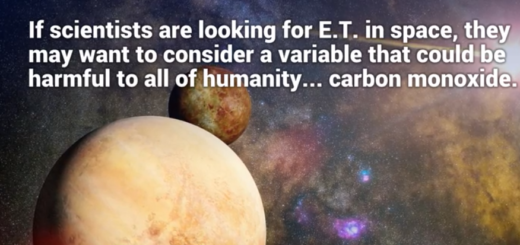Heads Up: Massive Dark Matter Hurricane Passing Earth

This NASA Hubble Space Telescope image shows the distribution of dark matter in the center of the giant galaxy cluster Abell 1689, which contains about 1,000 galaxies, trillions of stars and resides 2.2 billion light-years from Earth. NASA/JPL-CALTECH/ESA/INSTITUTE OF ASTROPHYSICS OF ANDALUSIA, UNIVERSITY OF BASQUE COUNTRY/JHU
A hurricane is upon us, but no need to run to the supermarket to stock up on milk and bread — nobody in this solar system will feel a thing because the storm is:
In space, and
Made of dark matter, the most mysterious stuff in the universe.
In fact, scientists are pretty excited about this storm because they’re hoping it will allow them to study dark matter in a way we never have before.
The problem scientists come up against when studying dark matter is that it’s invisible, and we haven’t yet invented anything to detect it. We can see it in action — in 1997 the Hubble Space Telescope captured an image of a distant cluster of galaxies bending the light of another galaxy cluster behind it. From this image, scientists were able to calculate the mass of the front cluster as 250 times greater than it should be, considering the combined mass of all the stars and planets and other “normal” matter inside it. Because things with mass are what glue galaxies together — thanks, gravity! — dark matter is probably what’s holding most of the stuff in the universe together. In fact, the type of matter we’re made of is probably the exception out in space, rather than the rule — by some estimates, only 5 percent of the substance in the universe is “normal” matter.
But, we can’t study this stuff that makes up an estimated 85 percent of our universe if we can’t detect it. Scientists are hoping, though, that this dark matter storm will give them the opportunity they need.
They got lucky, actually, because in 2017, a stellar stream called S1 was discovered by the European Gaia satellite. A stellar stream is a collection of stars, gas and space rubble that was once a dwarf galaxy itself, that collided with a larger galaxy — in the case of S1, our Milky Way. S1 was gobbled up, torn apart and stretched into a glob of old galaxy parts — including dark matter — that moves as a unit around our massive galactic core.
According to a study published Nov. 7, 2018, in the journal Physical Review D, the path of stellar stream S1 is right in line with our solar system, and all its dark matter is blowing through our corner of the Milky Way galaxy and passing over Earth — the dark matter hurricane. We can expect to be buffeted with 10 billion stars worth of dark matter at 310 miles per second (500 km/s), which are as favorable as any conditions for detecting something that’s all but undetectable.
But for the moment, scientists are pondering what kind of particles they need to be prepared to detect. Some are firing up their weakly interacting massive particle (WIMP) detectors while others are expecting dark matter particles will be more like axions.
Whatever happens, though, don’t worry — you won’t feel a thing.



 Creators of mankind
Creators of mankind Description of “Tall white aliens”
Description of “Tall white aliens” Where they came from?
Where they came from? About hostile civilizations
About hostile civilizations The war for the Earth
The war for the Earth “Tall white aliens” about eternal life
“Tall white aliens” about eternal life Video: “Nordic aliens”
Video: “Nordic aliens” Aliens
Aliens Alien encounters
Alien encounters The aliens base
The aliens base UFO
UFO Technology UFO
Technology UFO Underground civilization
Underground civilization Ancient alien artifacts
Ancient alien artifacts Military and UFO
Military and UFO Mysteries and hypotheses
Mysteries and hypotheses Scientific facts
Scientific facts


















